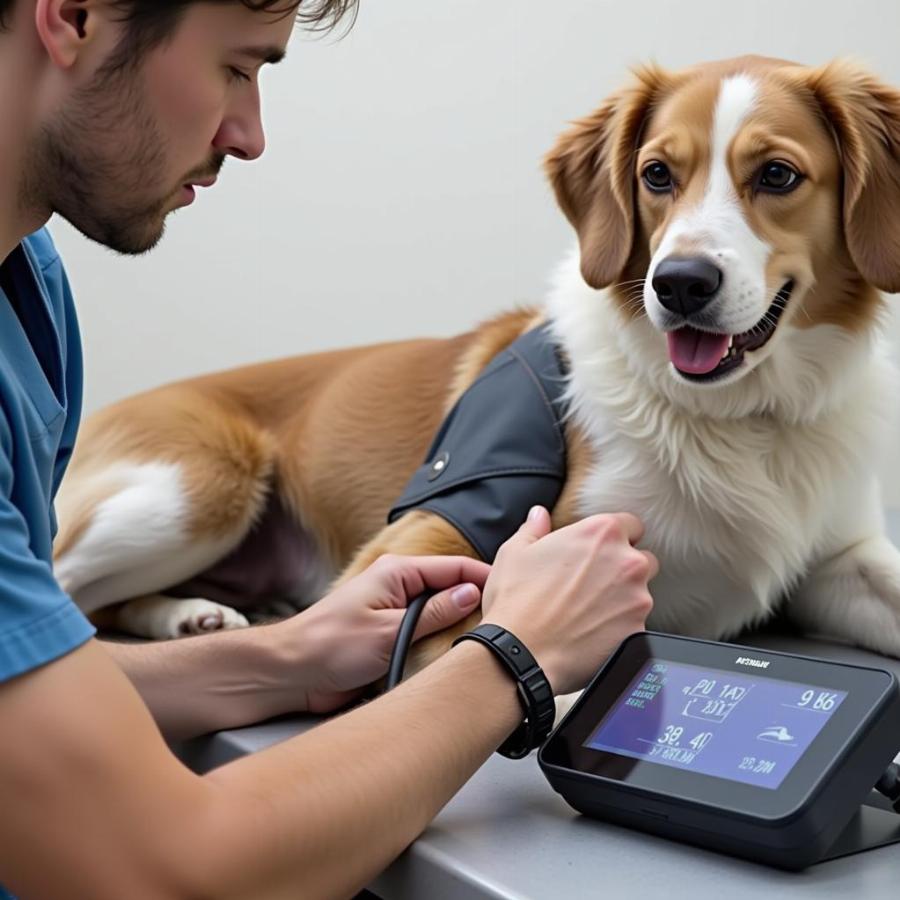Understanding your dog’s blood pressure is crucial for their overall health. Just like in humans, high blood pressure (hypertension) in dogs can lead to serious health problems affecting the heart, kidneys, eyes, and brain. Regular monitoring, especially for dogs with pre-existing conditions, can help detect potential issues early on. This guide will cover everything you need to know about blood pressure monitors for dogs, from choosing the right device to interpreting the readings.
Why Monitor Your Dog’s Blood Pressure?
High blood pressure in dogs often goes unnoticed because it rarely shows obvious symptoms. Regular blood pressure checks are especially important for senior dogs and those diagnosed with kidney disease, heart disease, Cushing’s disease, diabetes, or hyperthyroidism. Early detection of hypertension allows for timely intervention and management, potentially preventing serious complications.  Checking dog's blood pressure
Checking dog's blood pressure
Types of Blood Pressure Monitors for Dogs
There are two main types of blood pressure monitors used for dogs: Doppler and oscillometric. Doppler monitors use ultrasound to detect blood flow and are considered the gold standard in veterinary medicine. Oscillometric monitors, similar to those used at home for humans, are easier to use but may be less accurate in some cases. Choosing the right monitor depends on your needs and budget.
Doppler Blood Pressure Monitors
Doppler monitors are known for their accuracy and are often preferred by veterinarians. They require some training to use effectively but provide reliable readings.
Oscillometric Blood Pressure Monitors
Oscillometric monitors are more readily available and user-friendly, making them a convenient option for home monitoring. However, they can be affected by movement and anxiety, potentially impacting the accuracy of the readings.
How to Use a Blood Pressure Monitor on Your Dog
Regardless of the type of monitor, ensuring your dog is calm and relaxed is crucial for accurate readings. The process usually involves placing a cuff around your dog’s leg or tail. The cuff is then inflated, and the monitor measures the pressure. It’s important to follow the manufacturer’s instructions carefully for accurate results.
Understanding Blood Pressure Readings in Dogs
Normal blood pressure readings for dogs typically range from 110-160 mmHg systolic and 60-90 mmHg diastolic. Readings consistently above these ranges indicate hypertension. It’s essential to consult your veterinarian to interpret the readings and discuss any necessary treatment options. is bacon grease bad for dogs
How to Choose the Right Blood Pressure Monitor
Consider factors like accuracy, ease of use, and budget when choosing a blood pressure monitor for your dog. Consulting with your veterinarian can help you select the most suitable option for your dog’s specific needs.
What are the symptoms of high blood pressure in dogs?
While high blood pressure in dogs often has no visible symptoms, some signs might include nose bleeds, lethargy, or changes in vision. However, these symptoms can be associated with various other health issues, highlighting the importance of regular blood pressure monitoring, especially in older dogs and those with underlying conditions. what is laboured breathing in dogs
How often should I check my dog’s blood pressure?
The frequency of blood pressure checks depends on your dog’s health status. Your veterinarian will recommend an appropriate schedule, which may range from several times a year for healthy dogs to more frequent monitoring for dogs with hypertension or related conditions. what causes strokes in dogs
Dr. Emily Carter, DVM, a renowned veterinary cardiologist, advises, “Regular blood pressure monitoring is a simple yet powerful tool in maintaining our canine companions’ well-being. Early detection and management of hypertension can significantly improve their quality of life and prevent long-term health complications.”
Dr. Maria Rodriguez, a leading veterinarian specializing in internal medicine, adds, “Don’t underestimate the importance of accurate blood pressure readings. Invest in a reliable monitor and follow the instructions carefully to ensure the most accurate assessment of your dog’s health.”
Conclusion
Monitoring your dog’s blood pressure is an essential part of responsible pet ownership. Understanding the different types of monitors, how to use them effectively, and interpreting the readings can help you detect and manage hypertension early, ultimately contributing to your dog’s long-term health and well-being. sotalol for dogs
FAQ
-
Can I use a human blood pressure monitor on my dog? While technically possible, human blood pressure monitors are not ideal for dogs and may not provide accurate readings.
-
Where can I buy a blood pressure monitor for my dog? Veterinary clinics and online pet supply stores typically carry blood pressure monitors specifically designed for dogs. hepatocutaneous syndrome dog
-
How can I keep my dog calm during a blood pressure check? Creating a relaxed environment, using positive reinforcement, and ensuring the process is gentle can help keep your dog calm.
-
What are the treatment options for hypertension in dogs? Treatment typically involves medication, dietary changes, and managing underlying health conditions.
-
Are there any home remedies for high blood pressure in dogs? Always consult your veterinarian before trying any home remedies. They can advise on safe and effective management strategies.